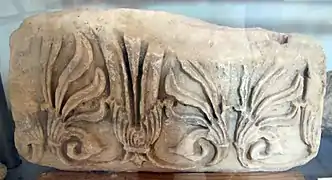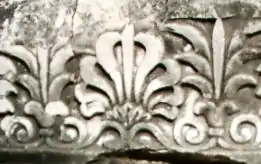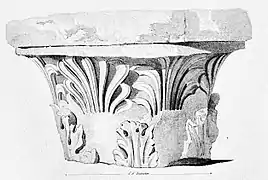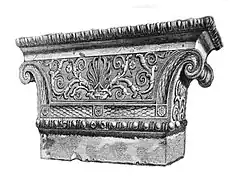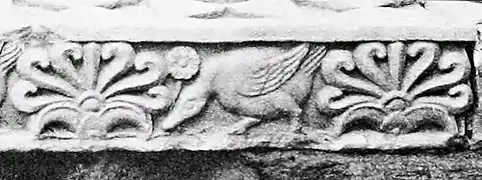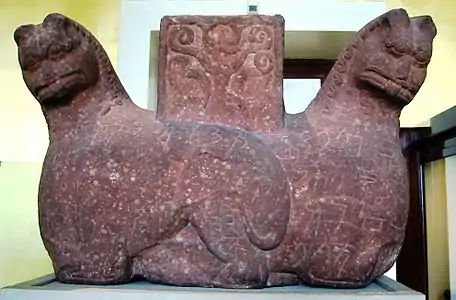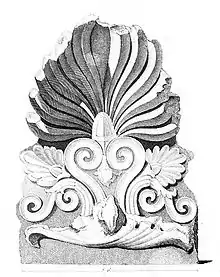

The flame palmette is a motif in decorative art which, in its most characteristic expression, resembles the fan-shaped leaves of a palm tree. Flame palmettes are different from regular palmettes in that, traditionally palmettes tended to have sharply splaying leaves. From the 4th century BCE however, the end of the leaves tend to turn in, forming what is called the "flame palmette" design.[1]
Greece
The first appearance of flame palmettes seem to occur with the stand-alone floral akroteria of the Parthenon (447–432 BCE),[2] and slightly later at the Temple of Athena Nike.[3] Flame palmettes were then introduced into friezes of floral motifs in replacement of the regular palmette. According to John Boardman, although lotus friezes or palmette friezes were known in Mesopotamia centuries before, the unnatural combination of various botanical elements which have no relationship in the wild, such as the palmette, the lotus, and sometimes rosette flowers, is a purely Greek innovation, which was then adopted on a very broad geographical scale.[4]

%252C_first_half_of_the_3rd_century_BC%252C_Ancient_Mieza_(7263729086).jpg.webp) A flame palmette at the Tomb of the Palmettes, first half of the 3rd century BCE, Mieza
A flame palmette at the Tomb of the Palmettes, first half of the 3rd century BCE, Mieza.jpg.webp) Flame palmettes at the Tomb of the Palmettes, first half of the 3rd century BCE, Mieza
Flame palmettes at the Tomb of the Palmettes, first half of the 3rd century BCE, Mieza%252C_a_panther%252C_palmettes_and_lotus_flowers%252C_East_side_of_the_House_of_the_Abduction_of_Helen%252C_Ancient_Pella_(6913841954).jpg.webp) Detail of mosaic. Ancient Pella
Detail of mosaic. Ancient Pella
Asia Minor
In Asia Minor, some of the earliest designs of flaming palmettes can be found in the Mausoleum at Halicarnassus, dated to 350 BCE. They are also extensively used at the 3rd century BCE Ionic Temple of Didyma.
| Flame palmettes in Asia Minor |
|
Greco-Bactria
The flame palmette design that was adopted in Hellenistic architecture and became very popular on a wide geographical scale, especially following the conquests of Alexander the Great. In the Greco-Bactrian city of Ai-Khanoum, founded circa 280 BCE, the antefixae display a flame palmette design, as do floral mosaics.
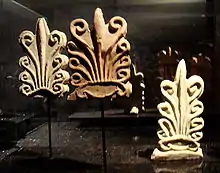 Architectural antefixae with Hellenistic "Flame palmette" design, Ai-Khanoum.
Architectural antefixae with Hellenistic "Flame palmette" design, Ai-Khanoum. Ai- Khanoum mosaic (central detail in color).
Ai- Khanoum mosaic (central detail in color).
India
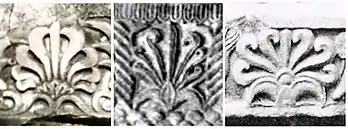
This is the design that was adopted by India in the 3rd century BCE for some of its sculptural friezes, such as on the abaci of the Pillars of Ashoka, or the central design of the Pataliputra capital, probably through the Seleucid Empire or Hellenistic cities such as Ai-Khanoum.[5]
| Flame palmettes in India |
|
References
- ↑ "Reflections on The origins of Indian Stone Architecture", John Boardman, p.16
- ↑ NEW FRAGMENTI'S OF THE PARTHENON ACROTERIA, The American School of Classical Studies at Athens
- ↑ The Sanctuary of Athena Nike in Athens: Architectural Stages and Chronology, Ira S. Mark, ASCSA, 1993, p.83
- ↑ The Origins of Indian Stone Archtitecture, John Boardman, p.16
- ↑ "Reflections on The origins of Indian Stone Architecture", John Boardman, p.16
External links
![]() Media related to Flame palmette at Wikimedia Commons
Media related to Flame palmette at Wikimedia Commons
